The Knights Templar
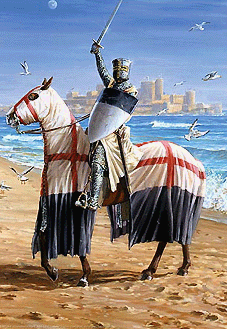 We go back in time, to a period between 1099 (First Crusade) and 1112. A small group of knights form the new order "Ordo Supremus Militaris Templi Hiero-solymitani", better known as the Knights Templar (also known as "Militia Templi" or "Les Pauvre Chevaliers du Temple"). They vowed poverty and their seal, showing two knights sharing one horse, is still recognizable today as the symbol of the (poor) Knights Templar. In spite of their vows, the Templars became very powerful in a very short period of time. Because of their charismatic essence, many rich, high born lords joined them and since they had to give up all their possessions to the order, the Order of the Knights Templar became very rich. It is also said, that these 9 knights were originally 9 descendants of the Royal House of Judah, also known as the 9 ring lords, which fled to other countries such as Turkey, France, Malta and Cyprus in the 1st century AD. This would have given them the blessings of the pope, which even went very far. They didn't have to pay taxes to the church of Rome and had carte blanche.
We go back in time, to a period between 1099 (First Crusade) and 1112. A small group of knights form the new order "Ordo Supremus Militaris Templi Hiero-solymitani", better known as the Knights Templar (also known as "Militia Templi" or "Les Pauvre Chevaliers du Temple"). They vowed poverty and their seal, showing two knights sharing one horse, is still recognizable today as the symbol of the (poor) Knights Templar. In spite of their vows, the Templars became very powerful in a very short period of time. Because of their charismatic essence, many rich, high born lords joined them and since they had to give up all their possessions to the order, the Order of the Knights Templar became very rich. It is also said, that these 9 knights were originally 9 descendants of the Royal House of Judah, also known as the 9 ring lords, which fled to other countries such as Turkey, France, Malta and Cyprus in the 1st century AD. This would have given them the blessings of the pope, which even went very far. They didn't have to pay taxes to the church of Rome and had carte blanche. Over the decades, the wealth and power of the order grew and grew. They were the founders of the largest banking system the world had ever seen. They built strongholds on strategic places and trade routes and levied heavy taxes on those who wanted to pass, or wanted their protection. Their financial and military independence made them feared by kings and popes. They obeyed no one. The fact that the king of France had a large debt with them, was the drop that made the bucket flow and this turned the fate of the order. But this doesn't conclude their story.
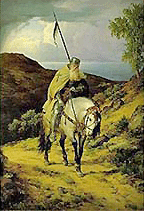 Many legends circle around their history. Why did the 9 lords form the Templar Order? (The number 9 refers to a sacred number (3x3 is extreme holy), but it is fictive, and the real number of knights were higher. But because 9 is a 'complete number', it was sufficient for the story. Sometimes there are only 9 Apostles on medieval frescoes, because this would mean that "they were all there"). Why did the crusaders take Jerusalem in the early 12th century, suddenly, after over a thousand years? Hughes de Payens and his "eight" friends vowed in the presence of the Patriarch of Jerusalem, to defend the Christians and the Christian kingdom, which was governed from Jerusalem. In the footsteps of Salomon and Jesus a new king was chosen. For the first time in a thousand years, the Knights Templar came very close to the secret vaults beneath the Templar mount.
Many legends circle around their history. Why did the 9 lords form the Templar Order? (The number 9 refers to a sacred number (3x3 is extreme holy), but it is fictive, and the real number of knights were higher. But because 9 is a 'complete number', it was sufficient for the story. Sometimes there are only 9 Apostles on medieval frescoes, because this would mean that "they were all there"). Why did the crusaders take Jerusalem in the early 12th century, suddenly, after over a thousand years? Hughes de Payens and his "eight" friends vowed in the presence of the Patriarch of Jerusalem, to defend the Christians and the Christian kingdom, which was governed from Jerusalem. In the footsteps of Salomon and Jesus a new king was chosen. For the first time in a thousand years, the Knights Templar came very close to the secret vaults beneath the Templar mount.The Knights Templar were Cistercians, and were protected by Cistercian father Bernard of Clairvaux. He believed that the Ark of the Covenant was still underneath the Temple mount. On his advice, the knights secretly dug their way into the vaults. During their stay in the Middle East, the Templars were introduced to knowledge and wisdom of the Orient. The knowledge of the stars, medicine, architecture, but they also learnt the true history of the first century. Many of these things were kept a secret and slowly but surely the Templars turned against the roman catholic church and their dogmas. Their dream was to form their own state in Occitania, because here they found relative safety for all, who had a different lifestyle or religion.
 With the growth of the Templar Order, many of the largest cathedrals of Europe were built. They introduced the gothic style, gothic meaning secret, not Visigoth. The Freemasons were formed to protect the newly found wisdom and knowledge of number, measure and weight. In the same period, the King Arthur stories and Holy Grail legends came into existence and the Troubadours invented courtly love. Chretien de Troyes was known for his work on the Holy Grail called "Conte de Graal", which was written at the end of the 12th century. This is the best kept and first text which tells us about the Holy Grail. The theme of the Holy Grail is an adventure, which leads us to the castle of the wounded king. There, a procession was held, led by virgins, who carried an object called The Holy Grail on their hands through the rooms of the castle. In this story it is a bowl, but much more than that is not obtained from this particular story, which was never finished due to Chretien de Troyes' early death.
With the growth of the Templar Order, many of the largest cathedrals of Europe were built. They introduced the gothic style, gothic meaning secret, not Visigoth. The Freemasons were formed to protect the newly found wisdom and knowledge of number, measure and weight. In the same period, the King Arthur stories and Holy Grail legends came into existence and the Troubadours invented courtly love. Chretien de Troyes was known for his work on the Holy Grail called "Conte de Graal", which was written at the end of the 12th century. This is the best kept and first text which tells us about the Holy Grail. The theme of the Holy Grail is an adventure, which leads us to the castle of the wounded king. There, a procession was held, led by virgins, who carried an object called The Holy Grail on their hands through the rooms of the castle. In this story it is a bowl, but much more than that is not obtained from this particular story, which was never finished due to Chretien de Troyes' early death.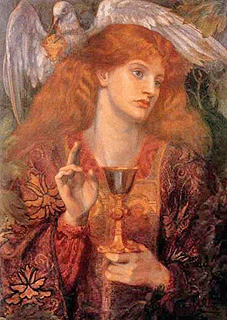 In his version of the Holy Grail we read nothing about a holy relic. Neither was it connected to the eucharist ritual, nor to the holy blood of Christ. Chretien de Troyes was neither Grandmaster or member of the Order of the Knights Templar.
In his version of the Holy Grail we read nothing about a holy relic. Neither was it connected to the eucharist ritual, nor to the holy blood of Christ. Chretien de Troyes was neither Grandmaster or member of the Order of the Knights Templar. He did write down several stories that he had heard from a troubadour from Occitania. This particular Grail story was among these stories. In this case, the original Grail story is from Occitania, not Germany or England. This would throw a different light on the origin of the Grail legends.
Many relics were kept in churches and cathedrals to attract pilgrims. To ensure a strong opposition against the Cathars and other non-catholic religions, the catholic Christianity was promoted by creating the stories around the Holy Grail and the (fake or real) relics to act as "solid" proof of the catholic dogma. When this didn't work, the church decided to show their teeth and claws. The pope called upon a new crusade, this time not to fight the Muslims, but to fight the Cathars and their protectors of Occitania. The king of France wasn't very keen on the crusade, but the pope demanded his assistance in the matter.
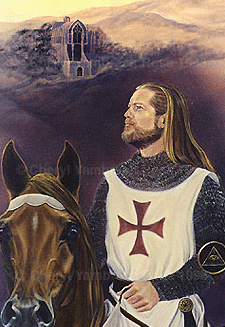 The first crusade to Occitania, for the greater part led by Simon de Montfort, failed. Occitania was re-conquered and for a short time, the Cathar population was relatively safe. Then a second crusade was organized by the pope under a new king of France. However, this second royal crusade wasn't only about a new attempt to crush the Cathar belief system. It was also about conquering Occitania for the French crown and to get the possessions and goldmines of the Knights Templar and the lands of the feudal Occitan Lords. In 1244, the year that Montsegur fell, Jerusalem was recaptured by the Muslims and Rome was angry. This time Occitania was taken and added to the French crown. In the fifty years that followed, there was still a hunt for the remaining Cathars and other heretics, who were, once they were found, burned at the stake.
The first crusade to Occitania, for the greater part led by Simon de Montfort, failed. Occitania was re-conquered and for a short time, the Cathar population was relatively safe. Then a second crusade was organized by the pope under a new king of France. However, this second royal crusade wasn't only about a new attempt to crush the Cathar belief system. It was also about conquering Occitania for the French crown and to get the possessions and goldmines of the Knights Templar and the lands of the feudal Occitan Lords. In 1244, the year that Montsegur fell, Jerusalem was recaptured by the Muslims and Rome was angry. This time Occitania was taken and added to the French crown. In the fifty years that followed, there was still a hunt for the remaining Cathars and other heretics, who were, once they were found, burned at the stake.In 1307, since there was no more need for them, also the Templars were arrested and accused of heresy, because this was the only way to get hold of their possessions. Many Knights Templar were banished, some were tortured to speak evidence of their un-Catholic practices which would prove their heresy. Their leaders were even publicly burned at the stake. We still remember Friday 13th 1307, the day of the arrest, because we still see Friday 13th as a day of bad luck. Officially, the Order was liquidated and their possessions were handed over to the Knights of St. John, better known as the Knights Hospitaler. However, their possessions, nor their treasures or relics, were ever found, except for a few items.
While the order was still alive in Portugal under the new name of Knights of Christ, they were still able to exist under their old name in Scotland. It is proven that the Knights Templar existed for at least (!) another 250 years in Scotland. Even today, the symbolism of St. Rosslyn in Scotland is a puzzle to many scholars. Legend tells us that the Templars managed to ship much of their possessions from France to Nova Scotia (New Scotland) where it is said that much of their treasure is still hidden. Parts of their treasure however were hastily hidden in caves all over Occitania, waiting to be discovered by a modern day Indiana Jones.
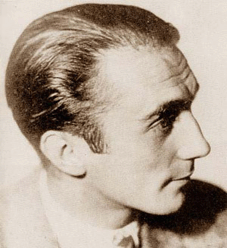 One of these modern Indiana Jones figures was German born Otto Rahn. No bold hero with a cowboy hat, but a sensitive poet who had so much love for Occitania, its culture and history. His research has connected Occitania with the Grail legends. His books, which he wrote in the early thirties of the 20th century, are now translated into English and form an idea of what Grail Rahn has found here in Occitania.
One of these modern Indiana Jones figures was German born Otto Rahn. No bold hero with a cowboy hat, but a sensitive poet who had so much love for Occitania, its culture and history. His research has connected Occitania with the Grail legends. His books, which he wrote in the early thirties of the 20th century, are now translated into English and form an idea of what Grail Rahn has found here in Occitania.
Like the Cathars, there are still Templar groups today, active in the positive elements of civilization, such as chivalry, virtue and the study of philosophy. Parts of their legacy is found among the Freemasons. Apart from the true Neo-Templars, some modern day Neo-Templar groups are just air. Many years ago, another one was even very evil. In the Second World War, Himmler formed a Nazi Neo-Templar group, which did dark deeds. Himmler even ordered Rahn to find the Grail for him in Occitania. All this may have been the background for Tolkiens "Lord of the Rings", a brilliant and recently filmed trilogy, which was written in 1954 and 1955. Power in the hands of humans isn't always safe.
It is probable that many of these new Templar Orders were inspired by Händel's opera "The Holy Grail", of which Hitler was a great admirer. But whether there was indeed such a dark Templar order has never been proven. It is however proven, that Hitler had this image in mind, when he formed the SS. During the Second Worldwar the real Order of the Knights Templar, at that time lead by Grandmaster Isaac van de Burgh, was given in the care of a Portuguese nobleman, Count Sousa Fontes, to be protected from the Nazi's.
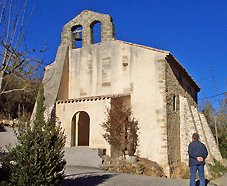 But we still don't know whether the old Knights Templar ever found the Ark of the Covenant. Some say that there are 5 Arks of which one is the original Ark of Moses. We can only speculate that they followed its trail to Ethiopia and brought back the Ark along with other objects from Jerusalem to France under the protection of Bernard of Clairvaux. Documents may substantiate this theory, as do traces in the French landscape. While many Templar Knights were only strong men with swords, the elite top of the order had possession of knowledge and great wealth. It is this small group of Grandmasters and noblemen, that would influence the world and its society for another thousand years, shaping legends and tales of courage, but most of all, of mystery...
But we still don't know whether the old Knights Templar ever found the Ark of the Covenant. Some say that there are 5 Arks of which one is the original Ark of Moses. We can only speculate that they followed its trail to Ethiopia and brought back the Ark along with other objects from Jerusalem to France under the protection of Bernard of Clairvaux. Documents may substantiate this theory, as do traces in the French landscape. While many Templar Knights were only strong men with swords, the elite top of the order had possession of knowledge and great wealth. It is this small group of Grandmasters and noblemen, that would influence the world and its society for another thousand years, shaping legends and tales of courage, but most of all, of mystery...With special thanks to the OSMTH, the present Order of the Knights Templar and especially to Chevalier Vincent Siegfried Sterring, KOT, hon.OStSS.
The Order of Knights Templar
The Ordo Supremus Militaris Templi Hierosolymitani
The OSMTH is based on an ancient Christian brotherhood, and is an international association of ecumenical Christians concerned with human rights, peace, religious and political freedom. As a network of educated professionals (politicians, military officers, diplomats, clergy, sociologists, anthropologists, physicians, historians, engineers), OSMTH represents a top-level pool of expertise and an influent voice to support commitment to peace and further the chivalric ideals of honesty, honour, tolerance and ecumenical faith throughout society and throughout the world.
The OSMTH is a registered NGO (non governmental organisation) of the United Nations and a member of the IPB (International Peace Bureau).
*****
Newsflash: Join us on our unique group tour in September 2014 with author Tim Wallace-Murphy and myself: The Lure of the Languedoc! More info: http://thelureofthelanguedoc.blogspot.com.

Under the nom de plume of Jeanne D'Août I have written a thriller called "White Lie" about the secrets of Occitania, the Knights Templar, the Cathars, Rennes-le-Chateau and relic hunter Otto Rahn. More info: www.jeannedaout.com

On February 23rd, 2013, I was interviewed on a live TV talk show in Las Vegas about my novel White Lie, and the secrets of Occitania. To see the interview, click here. ~ www.jeannedaout.com
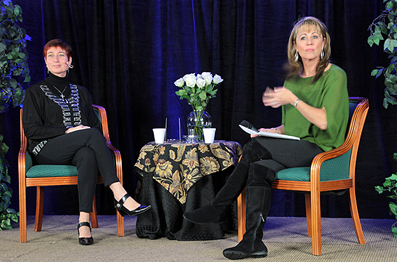
See for more information on The Knights Templar:
Knights Templar
Templar History